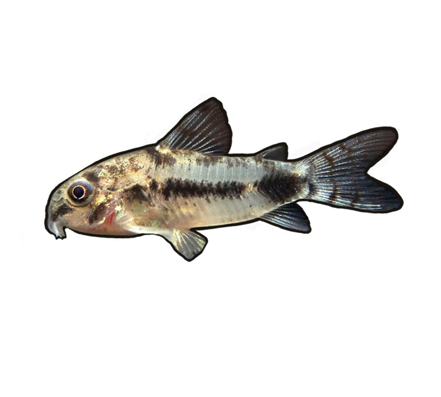
Dainty/Dwarf Spotted Cory Cat ( Salt and Pepper )
Please contact us at info@baybridgeaquarium.com to confirm immediately availability. Livestock inventory is subject to change and prior sale. Fish shipments may take several days to fulfill.
Click Here to See Images
Basics
Scientific Name: Corydoras habrosus
Family: Callichthyidae
Origin: Amazon, South America
Quick Facts
- Care Level: Easy
- Temperament: Peaceful
- Lifespan: 3-5 years
- Water Conditions: 77-80°F, pH 6.0-8.0
- Maximum Size: Up to 0.75" (2 cm)
- Diet: Omnivore
- Minimum Tank Size: 10 gallons
Overview
Dainty Cory Cats, also commonly known as the Salt and Pepper Cory, are one of three species of dwarf cory. They have slightly iridescent silvery bodies and a thick black line running along their sides as well as a splotch near the tail fin and black markings on the face, top of their heads and dorsal and tail fins. They are an armored catfish and have bony plates instead of scales, and a set of four barbels around their bottom facing mouths.
A peaceful, bottom dwelling species, cory cats are ideal for most freshwater community tanks. They will appreciate a planted aquarium with plenty of hiding places and cover. Fake plants and other decor items are also acceptable. A smooth sand substrate is best to bring out their natural sifting behavior; which is a delight to observe. It will also prevent wear on their delicate barbels. Cories are a shoaling fish and will feel most secure and be the happiest and healthiest in a school of six or more.
An omnivorous scavenger, cories require a well balanced, quality diet that should include live, frozen, freeze dried and pelleted food. Sinking wafers specifically designed for bottom feeders can be fed as a staple or as a supplement to live worms (bloodworms, tubifex, ect). Occasionally, they can also be fed blanched vegetables. They are ravenous eaters who will also clean up any food scraps missed by their tankmates, however, they should not be relied on to clean your tank and leftovers shouldn't be their primary diet.
Images used on this site are for informational purposes only, for actual photos of livestock please contact us (877) 809-4067.
